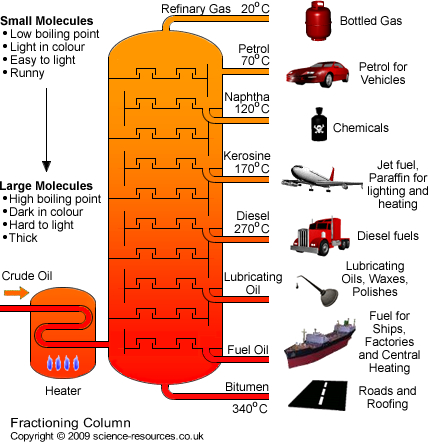5.6 recall that crude oil is a mixture of hydrocarbons
Hydrocarbons are compounds that contain hydrogen and carbon atoms only.
5.7 describe how the industrial process of fractional distillation separates crude oil into fractions
Fractions are groups of hydrocarbons with similar boiling points. They are separated by fractional distillation.
Fractional distillation is carried out to separate crude oil into its fractions. How is it carried out? (3-4m)
Crude oil is heated, vaporised, and pumped into a fractionating column, which is coolest at the top and hottest at the bottom. The larger hydrocarbons sink whilst the smaller hydrocarbons rise up the column. As they near the area where the temperature is close to their boiling point, they condense, and the fractions are collected. The refinery gases rise straight up and are collected as gases. The longer the chain of hydrocarbons, the higher its boiling point, thus the further down the fractionating column it will be.
5.8 recall the names and uses of the main fractions obtained from crude oil: refinery gases, gasoline, kerosene, diesel, fuel oil and bitumen
Note: Use the name in bold, gasoline is also known as petrol and kerosene is also known as paraffin but use gasoline and kerosene.
Name of fraction (in order of increasing molecule size) | Main uses |
Refinery gases | Fuels for lighters and cooking |
Gasoline (petrol) | Vehicles e.g. cars |
Kerosene (paraffin) | Jet fuel, paraffin heaters |
Diesel | Lorries |
Fuel oil | Fuel for ships, factories, central heating |
Bitumen | Roads and roofs |

5.9 describe the trend in boiling point and viscosity of the main fractions
As the size of the hydrocarbon molecules increases, the boiling point and viscosity increases. This is because with increasing chain length (more carbon atoms and therefore more hydrogen atoms), van der Waal’s forces of attraction between the molecules increases.
5.10 recall that incomplete combustion of fuels may produce carbon monoxide and explain that carbon monoxide is poisonous because it reduces the capacity of the blood to carry oxygen
Incomplete combustion of hydrocarbons produces carbon monoxide, water and soot.
Carbon monoxide is a poisonous gas. It combines with haemoglobin in the red blood cells and prevents it from carrying oxygen, hence reducing the capacity of the blood to carry oxygen.
5.11 recall that, in car engines, the temperature reached is high enough to allow nitrogen and oxygen from air to react, forming nitrogen oxides
Just recallthis. And if you want to know, nitrogen oxides are major pollutants, I mean just look at the exhaust fumes coming out of the vehicles on the road…
5.12 recall that fractional distillation of crude oil produces more long-chain hydrocarbons that can be used directly and fewer short-chain hydrocarbons than required
When they say the long-chain hydrocarbons can’t be used directly it’s basically telling you that they’re not very useful. With increasing chain length, the hydrocarbons become less flammable, more viscous and therefore less useful. So there isn’t much use for these heavy fractions, but there’s more of it, whilst there’s a higher demand for short-chain hydrocarbons.
Thus chemists have found a way to convert these large, less useful, heavy fractions into smaller, more useful ones…:
5.13 describe how long chain alkanes are converted to alkenes and shorter-chain alkanes by catalytic cracking, using silica or alumina as the catalyst and a temperature in the range of 600-700°
Crude oil is a mixture of hydrocarbons. It can be separated by fractional distillation. In the petrochemical industry some larger hydrocarbon molecules are broken down into smaller hydrocarbon molecules by cracking.
Describe how cracking is carried out: (2m)
A long chain hydrocarbon is put into a catalytic cracker where there is an absence of air, high temperatures of 600-700°C and a catalyst of aluminium oxide to speed up the process. The result is a mixture of smaller saturated and unsaturated hydrocarbons/alkanes+alkenes.
Explain why it is necessary to do this: (3m)
Smaller hydrocarbon molecules are less viscous and more flammable. Thus they are more useful and in higher demand. (Petrol, a short chain alkane is in higher demand than say, diesel.) Cracking also produces alkenes as a by-product which can be used to make plastics. This brings about a bigger profit. (I believe hydrogen is also obtained for the Haber process, to manufacture ammonia.)
Tidak ada komentar:
Posting Komentar